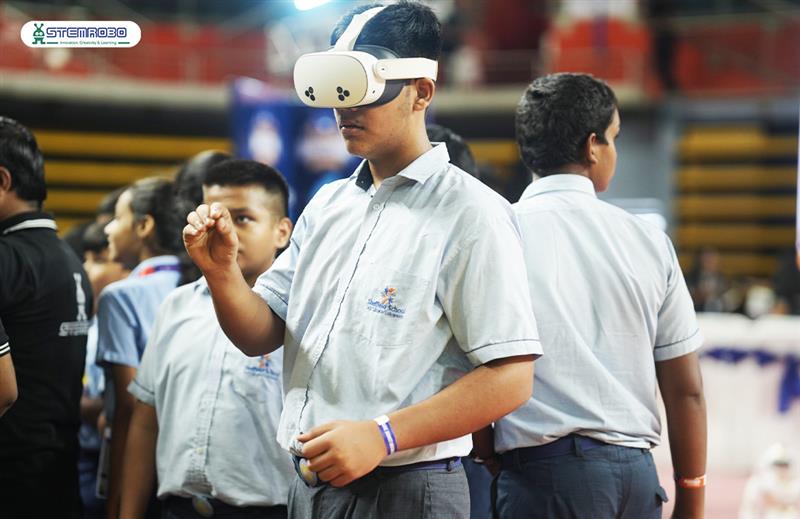The world is changing fast and it is important that schools also adapt to it in order to make the students ready for the future so that they can get the jobs they want, with ease. There is a trending concept of education going on, that is, virtual reality or more popularly, VR. This blog will help the parents, teachers, schools and all the stakeholders understand the importance and benefits of virtual reality.
What is Virtual Reality in Education?
Virtual Reality (VR), in simple terms is a three-dimensional environment that is created to make the users feel like they are entering into a totally different surrounding. This is made through computers. With the help of VR gadgets like headsets or other devices, a person can experience a new world, a new experience by just being in one place. VR helps the user to actually understand better through creating a different environment and surrounding.
For example:
• Learning how earthquakes occur
• The beating of a heart
• The flow of xylem and phloem
• War and war experiences
• Exploring planets and galaxies
These experiences are just a jist, a person can explore as much as they want and however they want, according to their heart’s content.
Advantages of Virtual Reality in Education
There are many benefits to using VR in traditional education. Some of them are –
1. Makes Learning Engaging and Fun
Traditional classes rely on books, pencils, blackboards and 2D images. But when students see and feel the objects, they learn better and understand more. This helps them retain the knowledge longer.
2. Improves Understanding of Complex Subjects
Some concepts are difficult to visualize. For example, understanding human anatomy from diagrams can be challenging. With VR, students can virtually “walk through” the human body and see how organs work in real time.
3. Bridges Geographical Gaps
Not every student can visit the Great Wall of China or NASA’s space center. But with VR in classroom, these experiences become possible. Students can take virtual field trips across the world without leaving their school.
4. Personalized Learning
Each student is different is different and so the teachers can easily customise the lessons according to the needs and wants of the students so that no child is left behind in the pursuit of greatness.
5. Safe Learning Environment
Some experiments involve risks and hence using a VR helps nullify those because students are working in a similar environment with no risks.
6. Builds Future-Ready Skills
The future wants candidates that are well versed with the practical knowledge, that is, they need to know how things work and function.
7. Encourages Creativity and Innovation
It doesn’t only teach the children but also pushes them to be more imaginative and curious. They learn how to think out of the box and also apply their knowledge in a real world situation.
VR in Classroom – Real-World Applications
The use of VR is not just a desire or a buzzword, it is actually very essential to use its expertise to make the kids well prepared for the future that demands skills more than the theoretical knowledge. they can learn any subject. They can learn history by walking through the establishments and ruins of civilisations, learn about the seven wonders of the world, that is, they can time travel. They can understand better about arithmetic, architecture, the textures of different rocks and also others.

The Future of Virtual Learning
The future of virtual learning looks promising with the integration of VR in education.
1. Blended Learning Models
Schools will combine traditional teaching with VR-based modules.
2. Global Classrooms
VR will make global classrooms a reality. A child in India could attend a class with students in the U.S. and Singapore, all Students connected through Virtual spaces.
3. Affordable and Accessible Education
As VR technology becomes a cheaper, even rural schools and Colleges will be able to provide high quality learning. experiences. This will reduce inequality in education Sector.
4. Skill Development Beyond Academics
VR not only focuses on technical knowledge but also teach the students about the essential 21st century skills like creativity, collaboration, curiosity etc.
5. Preparation for Future Careers
The future has jobs that aren’t even there yet and the students who are trained with the VR environment will find it easier to go through the job market. Because they will have more knowledge and practice through the Virtual reality environment.
How STEMROBO is Driving the VR Revolution
The future is very demanding and hence the students need to be prepared for it. This can be done when they actually learn to enjoy the things they learn, along with understanding them better and retaining them for a longer time.
By integration of Virtual Reality in education, students can explore a three dimensional world by just sitting at one place and the best part is that, they are inside that world. That is, they can travel through space, go underwater, explore planets, see how agriculture is done, etc.
For example –
In Science, a student can explore the human body, see chemical reactions, explore solar system and also see how the organisms work etc.
In Maths, students can explore the shapes and sizes, learn arithmetic, that is, they learn geometric better.
In Coding & Robotics, students can visualise a finalised product and also do hit and trial runs through Virtual Reality!
In Geography, students can explore mountains, the seas and also learn about the soil structures etc
Conclusion
In today’s education system, virtual education or VR lab is more than just a trend, it is as essential as traditional education. Virtual learning makes learning much more interesting and understandable. Through this, students can easily connect the theoretical knowledge to practical knowledge. This is an example of quality education that makes the students well prepared for the future and its challenges. They also learn the very important 21st century skills that supplement their knowledge.

